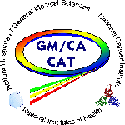The Advanced Photon Source
is located at Argonne National Laboratory in Argonne, IL
Each sector is run by a different Collaborative Access Team (CAT), that operates completely independently for the purposes of access, science, etc. Researchers use the APS either as members CATs or as General Users. Generally, 25% of beamtime is for use by General Users.
Overview
| Beamlines (xtal) | Owner/Operator | Status | Experiments | Wavelength (Å) |
|---|---|---|---|---|
| 5ID-B | 1 | Decommissioned | FLUORESCENCE | 0.62 - 2.47 |
| 8-BM | NE-CAT | Decommissioned | MAD | 0.886 - 1.908 |
| 14-BM-C | BioCARS, CARS, The University of Chicago | Operational | MONOCHROMATIC, FIBER | Fixed: 0.979 |
| 14-BM-D | BioCARS | Decommissioned | info not available | |
| 14-ID-B | BioCARS, CARS, The University of Chicago | Operational | MONOCHROMATIC, SAXS, WAXS, TIME RESOLVED LAUE, SOLUTION STUDIES | 0.6 - 1.8 |
| 17-BM | IMCA-CAT / XSD | operational | POWDER | 2.0 - 0.6 |
| 17-ID | IMCA-CAT | operational | MAD, MONOCHROMATIC | 2.0 - 0.7 |
| 18-ID | BioCAT | operational | SAXS | 0.035 - 0.3 |
| 19-BM | SBC-CAT | Operational | MAD, SAD, FLUORESCENCE | 2.0 - 0.92 |
| 19-ID | SBC-CAT | Operational | MAD | 2.032 - 0.670 |
| 21-ID-D | LS-CAT | Operational | MAD, SAD | 0.62 - 1.91 |
| 21-ID-F | LS-CAT | operational | SAD, MONOCHROMATIC | Fixed: 0.97857 |
| 21-ID-G | LS-CAT | operational | SAD, MONOCHROMATIC | Fixed: 0.97857 |
| 22-ID-E | SER-CAT/University of Georgia | Undergoing upgrade | MONOCHROMATIC | Fixed: 0.97 |
| 22-ID-D | SER-CAT/University of Georgia | Undergoing upgrade | MAD, SAD | 0.52 - 2.1 |
| 23-BM-B | GM/CA-CAT | Operational | MAD, SAD | 0.974 - 0.992 |
| 23-ID-B | GM/CA | operational | MAD, SAD | 0.62 - 2.5 |
| 23-ID-D | GM/CA | operational | MAD, SAD | 0.62 - 2.5 |
| 24-ID-C | NE-CAT | operational | MAD, SAD | 0.68 - 2.0 |
| 24-ID-E | NE-CAT | operational | SAD | Fixed: 0.98 |
| 31-ID | LRL-CAT, Eli Lilly & Company | Operational | MAD, SAD, MONOCHROMATIC | 0.56 - 2.47 |
In order to add a new beamline for this synchrotron you must have a registered account as Facility Data Manager for APS.
If so please click here to login (using slide-down form at top right of page).
Click here to add a New Beamline for APS
About Structural Biology at APS
 BioCARs
BioCARs
(Sector 14) The Consortium for Advanced Radiation Sources (CARS) is a multi-institutional (the Univ. of Chicago, Northern Illinois Univ., Southern Illinois Univ. at Carbondale, the University of Illinois at Chicago and the Australian Nuclear Science and Technology Organization (ANSTO)) multi-disiplinary consortium managed by the University of Chicago.
 DND-CAT
DND-CAT
(Sector 5) The DuPont - Northwestern -Dow Collaborative Access Team(sector 5), was not originally designed for macromolecular crystallography experiments, although a considerable fraction of the research conducted there is now in this area. The Web page describing their program is located at the following address: http://tomato.dnd.aps.anl.gov/macrocryst/
 GM/CA-CAT
GM/CA-CAT
(Sector 23) The (GM/CA-CAT) has been established by the National Institutes of Health's (NIH)National Institute of General Medical Sciences (NIGMS) and National Cancer Institute (NCI) to build and operate a national user facility for crystallographic structure determnation of biological macromolecules by x-ray diffraction. It is part of the Bioscience Division (BIO) at Argonne National Laboratory (ANL)
 IMCA-CAT
IMCA-CAT
(Sector 17) The Industrial Macromolecular Crystallography Association Collaborative Access Team, is dedicated to high-throughput macromolecular crystallography for pharmaceutical research in drug discovery. IMCA-CAT is funded by the pharmaceutical industry members of IMCA and is operated through the University of Chicago. Confidential and proprietary experiments are readily and easily accommodated. The beamlines are specially equipped with robotics for sample mounting, centering, screening, and data collection. Mail-in data collection with remote monitoring is offered.
 NE-CAT
NE-CAT
The Northeastern Collaborative Access Team (NE-CAT) is operated by Cornell University and funded by its member institutions (Columbia University, Cornell University, Harvard University, Massachusetts Institute of Technology, Memorial Sloan Kettering Cancer Center, Rockefeller University, and Yale University) and the National Institute of General Medical Sciences (NIGMS) to operate synchrotron X-ray beam lines to address technically challenging problems in structural biology.
 SBC-CAT
SBC-CAT
(Sector 19) The Structural Biology Center, is funded by the DOE Office of Biological and Environmental Research. The majority of beamtime is allocated to Independent Investigators.
 SER-CAT
SER-CAT
(Sector 22) The South East Regional Collaborative Access Team, consists of 24 member institutions across 11 states and the National Institutes of Health Intramural Program. SER-CAT is administered through the Department of Biochemistry and Molecular Biology at the University of Georgia. It stands out from other APS CATs in terms of its large diverse membership and its multiple sources of funding (mainly through state legislative funds, agencies, and the individual universities- at the university, department, or individual research group level).
